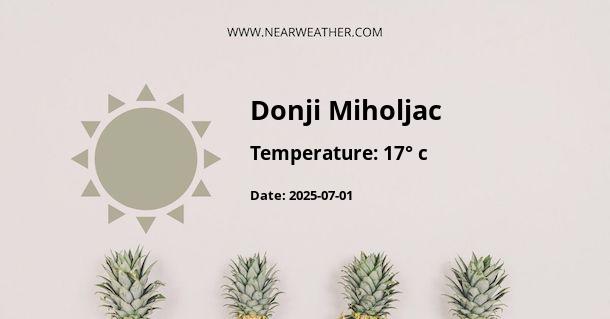Understanding Donji Miholjac's Climate and Weather Patterns
Donji Miholjac, a charming town located in eastern Croatia, is characterized by a temperate continental climate. This climatic zone is defined by warm summers and cold winters, a typical feature of inland areas situated away from the moderating influence of the sea. An in-depth examination of Donji Miholjac's climate will reveal the nuances of its seasonal weather patterns and offer insights into the best times of year to visit.
General Climate Overview
The climate in Donji Miholjac exhibits distinct seasonal changes. It is strongly influenced by its geographical position near the Drava River and the Pannonian Basin. The town experiences a considerable range in temperature throughout the year, with potential extremes during both summer and winter months.
"Donji Miholjac's climate is marked by its continental characteristics, which translates to significant temperature variations between seasons," notes the Croatian Meteorological and Hydrological Service.
Spring and autumn are generally mild but can be unpredictable, with fluctuating temperatures and occasional rainfall. Weather patterns during these transition seasons can change rapidly, reflecting the complex interactions between cold air masses from the northern continental interior and warmer, moist air from the Adriatic Sea.
Seasonal Climate Conditions
Winter Weather in Donji Miholjac
The winter months, from December to February, are cold with averages ranging from -2°C to 4°C (28°F to 39°F). However, temperatures can plummet well below freezing, and snowfall is common, particularly in January, which is typically the coldest month.
| Month | Average High | Average Low | Precipitation |
|---|---|---|---|
| December | 3°C (37°F) | -2°C (28°F) | 33 mm (1.3 in) |
| January | 2°C (35°F) | -3°C (27°F) | 28 mm (1.1 in) |
| February | 5°C (41°F) | -1°C (30°F) | 29 mm (1.1 in) |
Spring Weather in Donji Miholjac
As winter gives way to spring between March and May, temperatures rise gradually. Average temperatures range from 5°C (41°F) in March to a pleasant 20°C (68°F) by May. Rainfall increases, fostering the growth of the lush vegetation synonymous with this fertile region of Croatia.
- March: The snow melts and temperatures begin to climb, though nights remain chilly.
- April: The warming trend continues, with occasional rain showers signaling the arrival of spring.
- May: By late spring, the weather is quite mild and conducive to outdoor activities, with longer days and more sunshine.
Summer Weather in Donji Miholjac
Summertime, from June through August, is the warmest part of the year. Daytime highs often reach into the upper 20s to low 30s Celsius (mid-80s to low 90s Fahrenheit), with July and August typically being the hottest months. While summers are generally warm and sunny, they can also bring thunderstorms, particularly in the late afternoon and evening.
| Month | Average High | Average Low | Precipitation |
|---|---|---|---|
| June | 25°C (77°F) | 13°C (55°F) | 78 mm (3.1 in) |
| July | 27°C (81°F) | 15°C (59°F) | 64 mm (2.5 in) |
| August | 27°C (81°F) | 14°C (57°F) | 66 mm (2.6 in) |
Autumn Weather in Donji Miholjac
The town's climate transitions into autumn from September to November, with temperatures gradually decreasing. Early autumn can still be warm, but by November, the average highs dip to around 10°C (50°F). Rain is also more common in the fall, contributing to the seasonal mood with overcast and cool days, signaling the approach of winter.
- September: Even as the nights grow cooler, the warmth of summer lingers during the day.
- October: Temperatures continue to drop, and the landscape transforms with vivid autumn colors.
- November: The chill of the coming winter begins to set in, with occasional frost and foggy mornings.
Extreme Weather and Climate Events
While Donji Miholjac enjoys a typically continental climate, extreme weather events can occur. These might include intense heat waves during the summer, when temperatures can exceed 35°C (95°F), or cold snaps in winter, with temperatures dropping well below -10°C (14°F). Furthermore, heavy rain events leading to the swelling of the Drava River pose a risk of flooding, particularly in spring and autumn.
According to a report by the European Environment Agency, climate change is likely to impact the frequency and intensity of such extreme events across Europe, including Croatia's continental regions.
Climate Adaptation and Tourism Recommendations
For visitors planning to explore Donji Miholjac, the best times of year are late spring through early summer (May to June) or early autumn (September to October). These periods offer the most pleasant weather conditions for enjoying the outdoor sights and cultural events.
Climate adaptation strategies for those residing in or traveling to Donji Miholjac include preparing for seasonal extremes when packing. Expect to need warm, layered clothing for the winter months, and lighter wear, along with rain gear, for the unpredictable spring and autumn. During the summer, sun protection and hydration are key due to the high temperatures and sun exposure.
In conclusion, the climate of Donji Miholjac is a textbook example of a temperate continental climate, with a full range of seasonal variability. Its weather patterns, shaped by geographical influences and advancing climate change, are critical to consider for those living in this region and for tourists alike.
A - Donji Miholjac's Latitude is 45.760830 & Longitude is 18.167219.
A - Weather in Donji Miholjac is 3° today.
A - Climate Conditions in Donji Miholjac shows heavy intensity rain today.
A - Humidity in Donji Miholjac is 95% today.
A - Wind speed in Donji Miholjac is 25.88 km/h, flowing at 292° wind direction. today.
